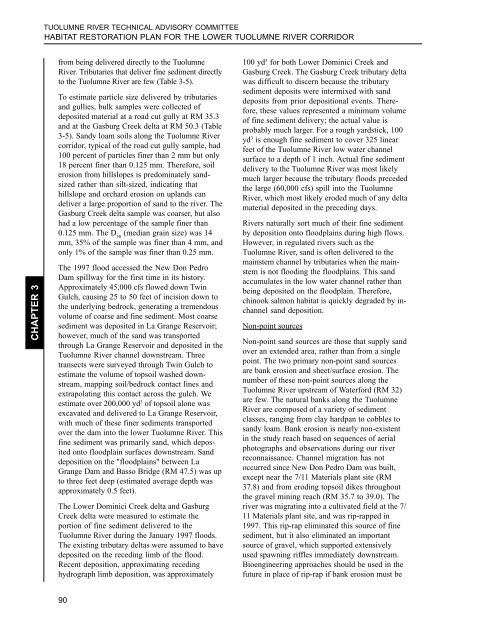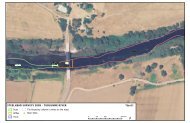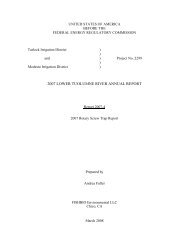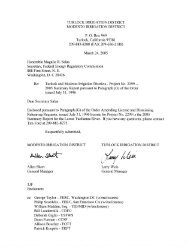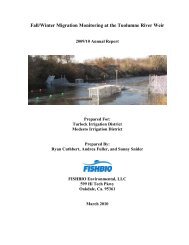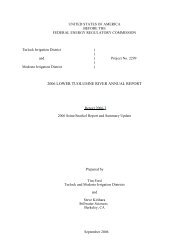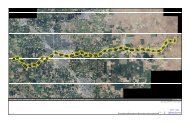Tuolumne River Report - U.S. Fish and Wildlife Service
Tuolumne River Report - U.S. Fish and Wildlife Service
Tuolumne River Report - U.S. Fish and Wildlife Service
You also want an ePaper? Increase the reach of your titles
YUMPU automatically turns print PDFs into web optimized ePapers that Google loves.
TUOLUMNE RIVER TECHNICAL ADVISORY COMMITTEEHABITAT RESTORATION PLAN FOR THE LOWER TUOLUMNE RIVER CORRIDORCHAPTER 3from being delivered directly to the <strong>Tuolumne</strong><strong>River</strong>. Tributaries that deliver fine sediment directlyto the <strong>Tuolumne</strong> <strong>River</strong> are few (Table 3-5).To estimate particle size delivered by tributaries<strong>and</strong> gullies, bulk samples were collected ofdeposited material at a road cut gully at RM 35.3<strong>and</strong> at the Gasburg Creek delta at RM 50.3 (Table3-5). S<strong>and</strong>y loam soils along the <strong>Tuolumne</strong> <strong>River</strong>corridor, typical of the road cut gully sample, had100 percent of particles finer than 2 mm but only18 percent finer than 0.125 mm. Therefore, soilerosion from hillslopes is predominately s<strong>and</strong>sizedrather than silt-sized, indicating thathillslope <strong>and</strong> orchard erosion on upl<strong>and</strong>s c<strong>and</strong>eliver a large proportion of s<strong>and</strong> to the river. TheGasburg Creek delta sample was coarser, but alsohad a low percentage of the sample finer than0.125 mm. The D 50(median grain size) was 14mm, 35% of the sample was finer than 4 mm, <strong>and</strong>only 1% of the sample was finer than 0.25 mm.The 1997 flood accessed the New Don PedroDam spillway for the first time in its history.Approximately 45,000 cfs flowed down TwinGulch, causing 25 to 50 feet of incision down tothe underlying bedrock, generating a tremendousvolume of coarse <strong>and</strong> fine sediment. Most coarsesediment was deposited in La Grange Reservoir;however, much of the s<strong>and</strong> was transportedthrough La Grange Reservoir <strong>and</strong> deposited in the<strong>Tuolumne</strong> <strong>River</strong> channel downstream. Threetransects were surveyed through Twin Gulch toestimate the volume of topsoil washed downstream,mapping soil/bedrock contact lines <strong>and</strong>extrapolating this contact across the gulch. Weestimate over 200,000 yd 3 of topsoil alone wasexcavated <strong>and</strong> delivered to La Grange Reservoir,with much of these finer sediments transportedover the dam into the lower <strong>Tuolumne</strong> <strong>River</strong>. Thisfine sediment was primarily s<strong>and</strong>, which depositedonto floodplain surfaces downstream. S<strong>and</strong>deposition on the "floodplains" between LaGrange Dam <strong>and</strong> Basso Bridge (RM 47.5) was upto three feet deep (estimated average depth wasapproximately 0.5 feet).The Lower Dominici Creek delta <strong>and</strong> GasburgCreek delta were measured to estimate theportion of fine sediment delivered to the<strong>Tuolumne</strong> <strong>River</strong> during the January 1997 floods.The existing tributary deltas were assumed to havedeposited on the receding limb of the flood.Recent deposition, approximating recedinghydrograph limb deposition, was approximately100 yd 3 for both Lower Dominici Creek <strong>and</strong>Gasburg Creek. The Gasburg Creek tributary deltawas difficult to discern because the tributarysediment deposits were intermixed with s<strong>and</strong>deposits from prior depositional events. Therefore,these values represented a minimum volumeof fine sediment delivery; the actual value isprobably much larger. For a rough yardstick, 100yd 3 is enough fine sediment to cover 325 linearfeet of the <strong>Tuolumne</strong> <strong>River</strong> low water channelsurface to a depth of 1 inch. Actual fine sedimentdelivery to the <strong>Tuolumne</strong> <strong>River</strong> was most likelymuch larger because the tributary floods precededthe large (60,000 cfs) spill into the <strong>Tuolumne</strong><strong>River</strong>, which most likely eroded much of any deltamaterial deposited in the preceding days.<strong>River</strong>s naturally sort much of their fine sedimentby deposition onto floodplains during high flows.However, in regulated rivers such as the<strong>Tuolumne</strong> <strong>River</strong>, s<strong>and</strong> is often delivered to themainstem channel by tributaries when the mainstemis not flooding the floodplains. This s<strong>and</strong>accumulates in the low water channel rather thanbeing deposited on the floodplain. Therefore,chinook salmon habitat is quickly degraded by inchannels<strong>and</strong> deposition.Non-point sourcesNon-point s<strong>and</strong> sources are those that supply s<strong>and</strong>over an extended area, rather than from a singlepoint. The two primary non-point s<strong>and</strong> sourcesare bank erosion <strong>and</strong> sheet/surface erosion. Thenumber of these non-point sources along the<strong>Tuolumne</strong> <strong>River</strong> upstream of Waterford (RM 32)are few. The natural banks along the <strong>Tuolumne</strong><strong>River</strong> are composed of a variety of sedimentclasses, ranging from clay hardpan to cobbles tos<strong>and</strong>y loam. Bank erosion is nearly non-existentin the study reach based on sequences of aerialphotographs <strong>and</strong> observations during our riverreconnaissance. Channel migration has notoccurred since New Don Pedro Dam was built,except near the 7/11 Materials plant site (RM37.8) <strong>and</strong> from eroding topsoil dikes throughoutthe gravel mining reach (RM 35.7 to 39.0). Theriver was migrating into a cultivated field at the 7/11 Materials plant site, <strong>and</strong> was rip-rapped in1997. This rip-rap eliminated this source of finesediment, but it also eliminated an importantsource of gravel, which supported extensivelyused spawning riffles immediately downstream.Bioengineering approaches should be used in thefuture in place of rip-rap if bank erosion must be90


